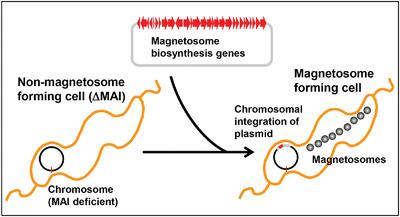当前位置:
X-MOL 学术
›
Biotechnol. J.
›
论文详情
Our official English website, www.x-mol.net, welcomes your
feedback! (Note: you will need to create a separate account there.)
Restoration and Modification of Magnetosome Biosynthesis by Internal Gene Acquisition in a Magnetotactic Bacterium.
Biotechnology Journal ( IF 3.2 ) Pub Date : 2020-08-26 , DOI: 10.1002/biot.202000278 Atsushi Arakaki 1 , Mayu Goto 1 , Mina Maruyama 1 , Takuto Yoda 1 , Masayoshi Tanaka 2 , Ayana Yamagishi 1 , Yasuo Yoshikuni 3 , Tadashi Matsunaga 1, 4
Biotechnology Journal ( IF 3.2 ) Pub Date : 2020-08-26 , DOI: 10.1002/biot.202000278 Atsushi Arakaki 1 , Mayu Goto 1 , Mina Maruyama 1 , Takuto Yoda 1 , Masayoshi Tanaka 2 , Ayana Yamagishi 1 , Yasuo Yoshikuni 3 , Tadashi Matsunaga 1, 4
Affiliation

|
Integration of a large‐sized DNA fragment into a chromosome is an important strategy for characterization of cellular functions in microorganisms. Magnetotactic bacteria synthesize intracellular organelles comprising membrane‐bound single crystalline magnetite, also referred to as magnetosomes. Magnetosomes have gained interest in both scientific and engineering sectors as they can be utilized as a material for biomedical and nanotechnological applications. Although genetic engineering of magnetosome biosynthesis mechanism has been investigated, the current method requires cumbersome gene preparation processes. Here, the chromosomal integration of a plasmid containing ≈27 magnetosome genes (≈26 kbp region) in a non‐magnetic mutant of Magnetospirillum magneticum AMB‐1 using a broad‐host‐range plasmid is shown. The genome sequencing of gene‐complemented strains reveals the chromosomal integration of the plasmid with magnetosome genes at a specific site, most likely by catalysis of an endogenous transposase. Magnetosome production is successfully enhanced by integrating a variation of magnetosome gene operons in the chromosome. This chromosomal integration mechanism will allow the design of functional magnetosomes de novo and M. magneticum AMB‐1 may be used as a chassis for the designed magnetosome production.
中文翻译:

在趋磁细菌中通过内部基因获取来恢复和修饰磁小体的生物合成。
将大型DNA片段整合到染色体中是表征微生物细胞功能的重要策略。趋磁细菌合成包含膜结合单晶磁铁矿(也称为磁小体)的细胞内细胞器。磁小体可以用作生物医学和纳米技术应用的材料,因此在科学和工程领域都引起了人们的兴趣。尽管已经研究了磁小体生物合成机制的基因工程,但是当前的方法需要繁琐的基因制备过程。这里,包含≈27磁小体基因(≈26kbp的区域)中的非磁性突变体的质粒的染色体整合磁螺magneticum显示了使用宽宿主范围质粒的AMB-1。基因互补菌株的基因组测序揭示了质粒与特定位点的核小体基因的染色体整合,这很可能是内源转座酶的催化作用。通过整合染色体中磁小体基因操纵子的变异,成功地增强了磁小体的生产。这种染色体整合机制将允许重新设计功能性磁小体和M. magneticum AMB-1可用作设计磁小体生产的底盘。
更新日期:2020-08-26
中文翻译:

在趋磁细菌中通过内部基因获取来恢复和修饰磁小体的生物合成。
将大型DNA片段整合到染色体中是表征微生物细胞功能的重要策略。趋磁细菌合成包含膜结合单晶磁铁矿(也称为磁小体)的细胞内细胞器。磁小体可以用作生物医学和纳米技术应用的材料,因此在科学和工程领域都引起了人们的兴趣。尽管已经研究了磁小体生物合成机制的基因工程,但是当前的方法需要繁琐的基因制备过程。这里,包含≈27磁小体基因(≈26kbp的区域)中的非磁性突变体的质粒的染色体整合磁螺magneticum显示了使用宽宿主范围质粒的AMB-1。基因互补菌株的基因组测序揭示了质粒与特定位点的核小体基因的染色体整合,这很可能是内源转座酶的催化作用。通过整合染色体中磁小体基因操纵子的变异,成功地增强了磁小体的生产。这种染色体整合机制将允许重新设计功能性磁小体和M. magneticum AMB-1可用作设计磁小体生产的底盘。











































 京公网安备 11010802027423号
京公网安备 11010802027423号